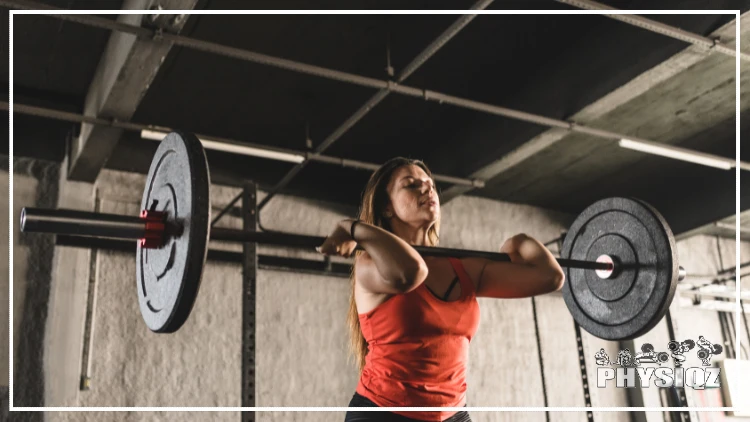
While each of these lifting exercises work similar muscle groups, some muscles are targeted much more in the hang clean vs power clean and the movements themselves vary, especially with the power clean incorporating an extra pull.1
The hang clean is the most beginner-friendly and safest option between the hang clean, the power clean, and the squat clean–due in part to less range of motion overall–but each lift has its own certain benefits and all can improve athletic performance for athletes in other sports.
For this reason, we’ll cover the difference between the movements, their benefits, when to use each for specific sports and/or goals, and when the squat cleans are best.
Key Differences Between the Hang Clean vs Power Clean
The hang clean is a type of lift with two distinct pulls, whereas the power clean incorporates three pulls and spans across a wider range of motion as the weight starts from the floor rather than already being held.2 It is essentially a full clean but starts in a hanging position instead.
Alternatively, the power clean is a clean that is caught in a “power” or partial squat position. Specifically, the bar should be caught in a quarter squat.
Overall the hang clean and power clean do work very similar muscles, but some of those muscles are targeted much more in one exercise than in the other. For example, thoracic extension is heightened in the power clean because of the first pull, which is completely absent in the hang clean.
Both of these lifts are excellent additions to powerbuilding programs, but individuals focused on getting stronger but not bigger might prefer one over the other to target specific muscles more effectively.
If you’re still unsure what all the cleans mean, check out this video for a full description of hang clean, power cleans, and full cleans:
Movement & Form Differences in Hang Cleans & Power Cleans
Anyone starting beginner powerlifting programs might not be familiar with the hang clean and power clean movements and the necessary form. To briefly explain, the hang clean involves lifting a barbell from a hanging position around thigh or knee level to the shoulders in a rapid motion, while the lifter bends their knees to catch and absorb the weight before quickly returning to a standing position.
Though the hanging level of the barbell can range somewhat between the hips and knees, kinetic comparisons in variations of the power clean and hang clean show that when training for maximum power, one should start with the bar at mid thigh.3
Alternately, the power clean does closely resemble the end of the hang clean, but starts out with the barbell on the floor instead of hanging and ends by catching the weight above parallel squat position, whereas in the hang clean the barbell is caught below.
How To Hang Clean
The hang clean can be done with alternative instruments to the barbell clean–such as in the kettlebell clean and dumbbell clean–or practiced on the Smith machine, but the traditional or most common hang clean is done with a barbell.
This exercise is like a deadlift combined with a front squat and works many muscles but primarily targets the hamstrings, erector spinae, and the glutes. The hang clean is a great step up to doing the Olympic clean and jerk.
The following pictures and instructions detail how to hang clean:
Step 1: Beginning with the bar on the floor, place feet hip width apart and hands on the bar at or just slightly wider than shoulder width apart in a hook grip.4
Step 2: Bring the barbell up to about thigh level and stand up. Again, hanging levels vary depending on preference or muscles targeted and can range from just below hip level down to knee level, so find a comfortable position in that area to start from (beginners may want to start just above the knees around mid-thigh, as pictured).
The hips should now be slightly pushed back, knees bent slightly and back mostly straight with very minimal lumbar curvature.
For the hang clean, this stance with the barbell already hanging from the arms is considered the starting position.
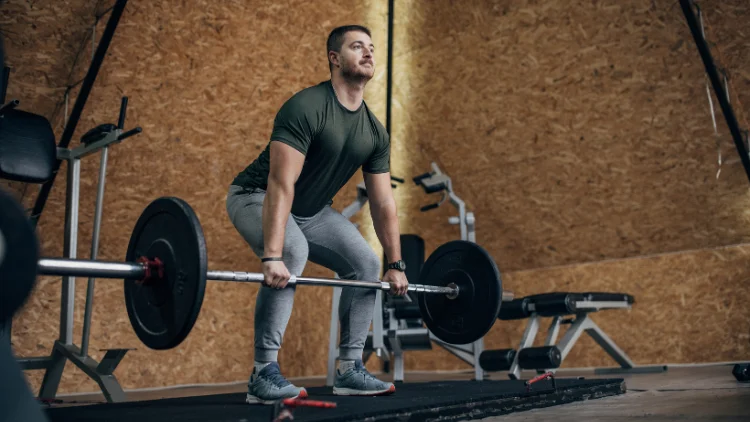
Source: Hirurg via Canva.com5
Step 3: With the heels remaining on the ground and arms straight, drive down through the heels and explosively extend the hips and knees, bringing the torso into a vertical position and lifting the bar up, keeping it close to the body but using power from the legs and hips to drive it up rather than using arm strength. The arms are more for directing or guiding the barbell to its next position rather than lifting it.
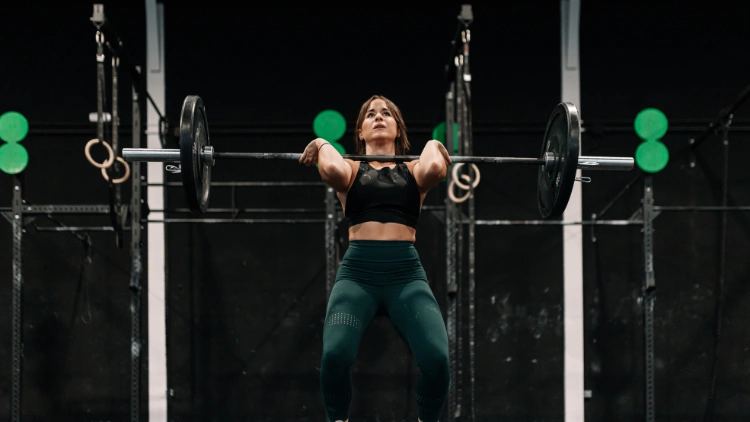
Source: vientocuatrostock via Canva.com6
Step 4: Do a simultaneous shoulder shrug and pull under as the bar reaches its peak height, then quickly reposition the body into a front squat stance to catch the bar at the shoulders as it comes back down, with the elbows now pointing forward and ahead of the body.
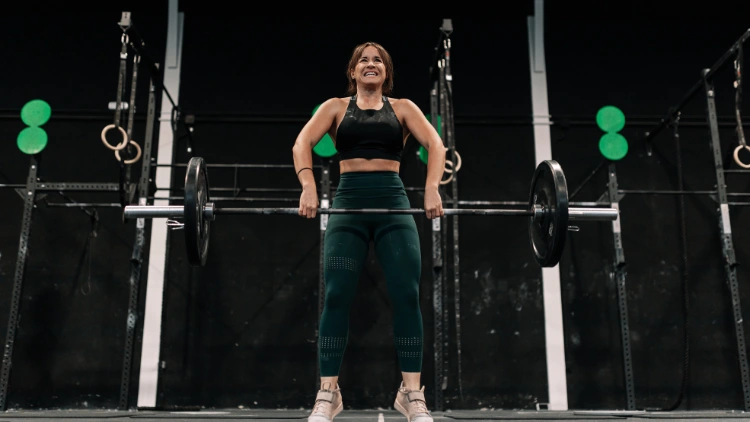
Source: vientocuatrostock via Canva.com7
Step 5: Immediately after catching the bar, return to standing position with full knee and hip extension and the bar in a front rack position. This completes one rep.
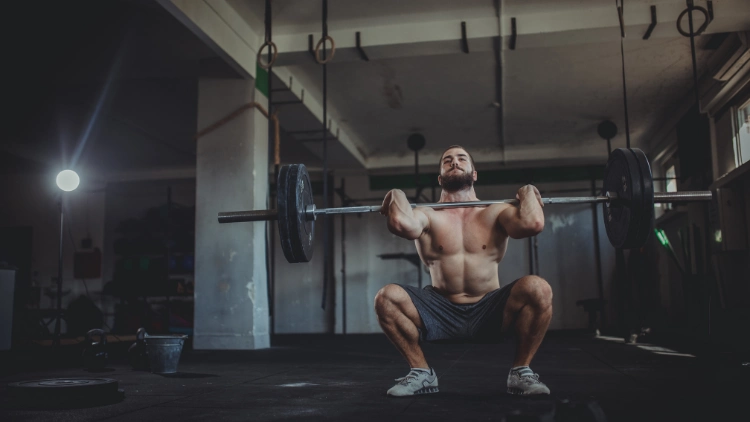
Source: South_agency via Canva.com8
Hang Clean Form & Technique Mistakes
Muscle strain and injuries can be extremely common in full body lifting movements due to the dynamic and compound nature of the movements and the multitude of muscles involved, so it is of utmost importance to be educated and knowledgeable of proper lifting form and techniques and what to be aware of.
Common hang clean form and technique mistakes include:
- Swinging the bar too far away from the body (increases lower back strain)
- Keeping too tight of a grip on the bar (should be loose enough for easy transitioning)
- Pulling with the arms
- Adding too much weight
- Catching the bar in an improper position (can cause uneven weight distribution and injury)
How To Power Clean
The power clean is somewhat similar to the squat clean, but the bar is caught above a parallel squat position instead of below. The power clean can also integrate variations such as training on the Smith machine or switching out the barbell for the kettlebell or db power clean.
Medicine ball slams and overhead throws can really increase power and explosiveness for the power clean as well.
While these alternatives are available and do have their own place and purpose, let’s get into how to power clean with the traditional barbell.
Step 1: With the barbell on the floor, stand with feet hip width apart and bend at the knees and hips to grab the bar in a hook grip. Hands should be only slightly more than shoulder distance apart.
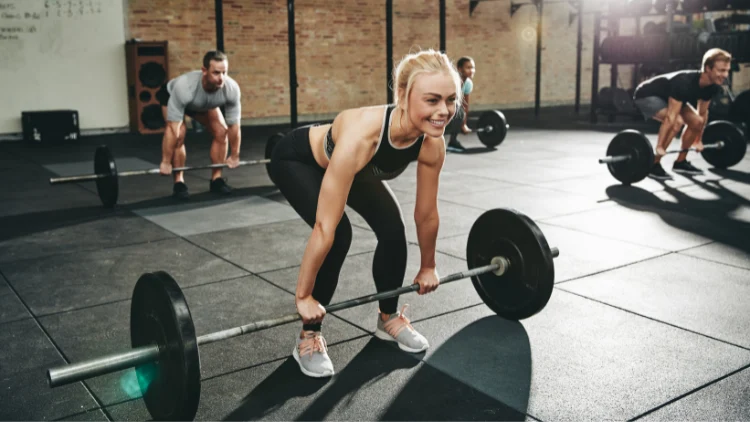
Source: StefanDahl via Canva.com9
Step 2: With shoulders just over and past the bar, ensure both heels stay on the floor and keep just a slight lumbar spine curvature, rapidly pushing down through the heels to raise and extend the hips and shoulders simultaneously, arms kept straight until the hips and legs are fully extended, then transition through to a shoulder shrug and pull under motion.
Although this seems to be a lot of movements in one step, these are all done almost instantaneously and are all integral to this lift. This first pull will really work the posterior chain so be sure to keep proper form so as to avoid injury.
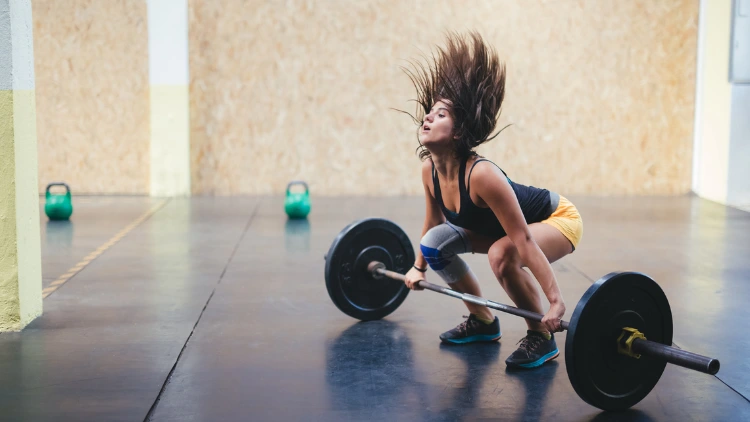
Source: urbazon via Canva.com10
Step 3: As the bar moves upward, quickly reposition the body into a partial squat position to catch the bar. Note that this is not a deep or full squat, just a slight dipping or bending of the knees to absorb the weight as it comes back down.
Note: The full squat catch position is done in another variation called the squat clean, which is essentially the first portion of the clean and jerk and is more challenging than the power clean because the lifter must get much lower.
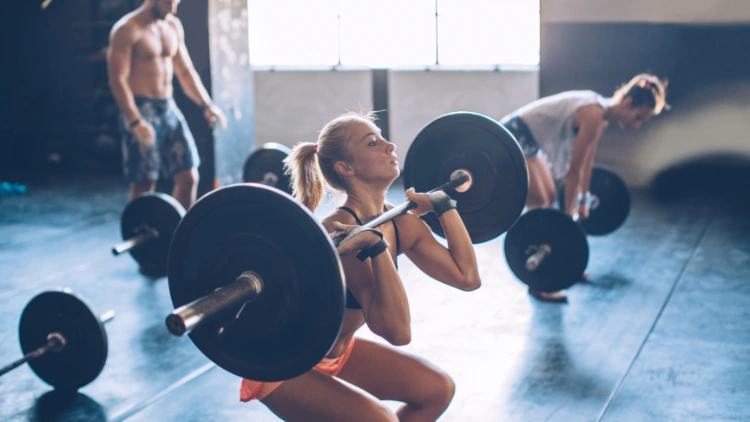
Source: svetikd via Canva.com11
Step 4: Stand up straight into full knee and hip extension with the bar in rack position to complete one rep.
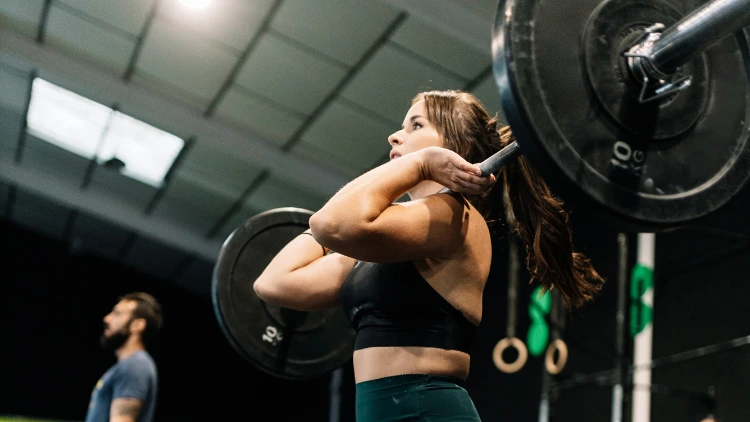
Source: vientocuatrostock via Canva.com12
Power Clean Form Mistakes
To reiterate, such a dynamic lift can easily lead to extensive injuries or muscle strain if improper form is used or if one rushes and neglects proper form. Safety should never be brushed aside for speed or strength, as one minor slip up can cause major setbacks.
Common power clean form and technique mistakes include:
- Improper starting position (back should be mostly straight with just slight lumbar curvature and hips should be behind the shoulders)
- Too much back curvature (while a slight curvature is okay and even recommended by some, too much can add extra strain and make injury more likely)
- Too much weight added (this will also cause too much back curvature and make improper form and injury much more likely)
- Too wide of a stance in starting position and/or after jumping to catch the weight (should always keep feet shoulder width apart)
- Pulling or catching with the arms (the lower body should be doing most of the work at all times)
- Not bracing laterally. The same way you brace and breathe for squats should be applied to every clean. This can help to avoid injury by supporting the spine under load.
Muscles Worked in Power Clean vs Hang Clean
In the hang clean vs power clean, one may be surprised that most of the muscles worked overlap but some of those muscles are targeted and activated much more in the hang clean than in the power clean and vice versa.
However, in the comparison between power clean and hang clean, the muscles worked differ significantly between the two exercises. For instance, the posterior chain is highly activated during the first pull of the power clean, whereas this initial phase is absent in the hang clean, resulting in less emphasis on the posterior chain in that movement.13
Interestingly enough, muscle synergies in the power clean were studied and also show that lifters highly trained in these exercises can actually develop much more coordination and muscle control over time than those who are inexperienced in these movements.14
While both the hang clean and the power clean build strength, increase hypertrophy, and help train the body for explosiveness in other sports, there are some key differences in muscles worked in each lift.
Hamstrings: The hamstrings provide help with lifting, stabilization of the legs, and extension of the hips in both the power clean and hang clean. Although they do get good engagement in the power clean’s first pull up from the floor, the hamstrings are actually utilized even more in the hang clean because they’re heavily targeted in the hanging position itself.
The hamstrings are also activated in both exercises to help with the catch phase as well.
Quads (Quadriceps Femoris): These muscles are engaged in the power clean to lift the barbell up from the floor, and then used in the other movements in both lifts to stabilize the legs and extend the knees, especially right after the catch when returning to standing position.
Glutes (Gluteus Maximus, Medius & Minimus): The glutes are most engaged in the power clean in the initial lift phase. They are also used in both exercises to help thrust the hips forward.
Spinal Erectors (Erector Spinae): The erector spinae is responsible for supporting the back when the body is bending forward, so it is targeted during the first pull of the power clean and the explosive lifts in both exercises, but is also highly engaged in the hanging position of the hang clean.15 Though the erector spinae is utilized most during the lifting, it does help stabilize the spine throughout the full movement of both the hang clean and the power clean.
Lats (Latissimus Dorsi): The lats are not specifically targeted in either lift, but these muscles do help with both control and stabilization of the spine in both exercises.
Traps (Trapezius) & Deltoids: Paired together here because of the similar role that they play in the hang clean and power clean, the traps and deltoids both serve to maintain stabilization of the vertebral column in both lifts, and are especially targeted in the initial pull of the power clean and in catching the bar in both lifts.
Calves (Triceps Surae): These muscles, as part of the posterior chain, provide extension and flexion of the ankles and are integral to getting the body repositioned just before the catch in both of these lifts.
Abdominal Muscles: While the abs are worked throughout the hang clean and power clean from start to finish, they are most utilized when working in tandem with the lower back to support the spine and to stabilize the trunk when catching the weight.
Biceps (Biceps Brachii): The biceps help with the pulling motion (although the hips and legs provide most of the power) and flex the elbows to get them into position before the catch.
Forearm Flexors: The forearm flexors are used fairly evenly across both the hang clean and power clean to grip the bar.
When To Use Hang Cleans, Power Cleans &/or Squat Cleans Depending on Goals & Objectives
The hang clean is advised for beginners, as the smaller range of movement is easier than lifting from the floor and can help establish a balanced and proper position before starting the second pull.
The hang clean can also be used on lighter lifting days or to train for explosivity and force through the extension and pull under as the bar must be moved more quickly through a small distance.
The power clean spans across a much larger range of motion than in the hang clean, and can be used to train for increased force and speed in the second and third pulls due to the minimal time frame to get positioned under the bar. The power clean can also be used in a progression routine for novices or as an alternative to those who can’t get into a full front squat stance.
The power clean is easily transitioned into a squat clean, while the hang clean is good for training the first portion of movements in the jerk and clean.
Alternatively, the squat clean can be best for improving stability and posture, increasing total body strength and hypertrophy, and aiding in mobility. Furthermore, the it creates more power and explosiveness which in turn makes for better overall athletic performance.
Those confident and experienced in their form and technique across all lifts could incorporate them into a periodization plan to achieve balance and maximize benefits. This includes harnessing the explosive power required from the hips in the hang clean, activating the posterior chain with the power clean, and enhancing stability and overall strength with the squat clean.
Benefits of Hang Cleans vs Benefits of Power Cleans
It has become clear that both hang clean and power clean provide many features that overlap but there are some differences in the benefits of each.
Benefits of Hang Cleans:
- Builds greater explosivity from the hips
- Improves the second pull for the power clean
- Transitions well to the clean and jerk
- Reduces the likelihood of injury due to fewer movements and smaller range of motion
- Targets the erector spinae and the hamstrings
Benefits of Power Cleans:
- Larger range of motion for increased overall muscle activation
- Incorporates three different pulls for greater muscle recruitment
- Transitions well to the squat clean
- Provides added engagement of the quads and the glutes in the first pull
- Incorporates full extension
Power Clean vs Hang Clean for Different Sports: Which Is Best?
Though the power clean and the hang clean can both be great exercises for improving athletic performance, the hang clean is recommended for football players to train strength and explosivity, basketball players to increase their vertical, and others including swimmers and CrossFit athletes for power.
The power clean is ideal for those training to improve running, jumping, and volatility especially due to the intense muscle contractions when lifting up from the ground. Athletes in soccer, basketball, football, volleyball, and track and field will all benefit from this lift.
For powerlifting and powerbuilding, either lift can be integrated into a compound movement routine or training program, and the clean and press is another great option for overall strength, hypertrophy, and balance. To be fair, just about any athlete can benefit from hang cleans and power cleans–which one to use just depends what muscles they’re training.
To maximize benefits of these lifts, athletes might want to consider that using wearable resistance while doing the power clean improves athletic performance.16 As always, only progress to variations or added weight or resistance if technique and form are fine tuned.
Although the power clean and the hang clean can give athletes an edge in terms of strength, hypertrophy, and explosive speed, other exercises like squats, deadlifts, and bench pressing all likely have better carry over to the movements and agility needed in most sports, so don’t go all in on these two lifts.
How To Choose Between Hang Cleans & Power Cleans Based on Your Goals
Both the hang clean and the power clean are excellent lifts for individuals aiming to build muscle and gain strength, often emphasized in various powerlifting programs. Since it can be difficult to know which to go with, keep in mind that the hang clean is likely the preferred option for someone wanting to focus on certain muscles and hone in within a smaller range of motion or for beginners learning balance and positioning, while those wanting to increase jumping and running abilities might prefer working the posterior chain in the power clean.
Both the hang clean and the power clean work muscles throughout the entire body and are amazing all-around lifts. Furthermore, each of these lifts can be greatly improved or built upon by other exercises that require similar movements or recruit the same muscle groups.
Some of the exercises that carry over well to both the hang clean and power clean in terms of movement and explosiveness include:
- Jump squats
- Hill sprints
- Box jumps
- Standing long jumps
- Medicine ball slams
- Medicine ball overhead throws
- Pull ups
- Jump squats
- Dumbbell step ups
- Kettlebell swings
- Kettlebell snatches
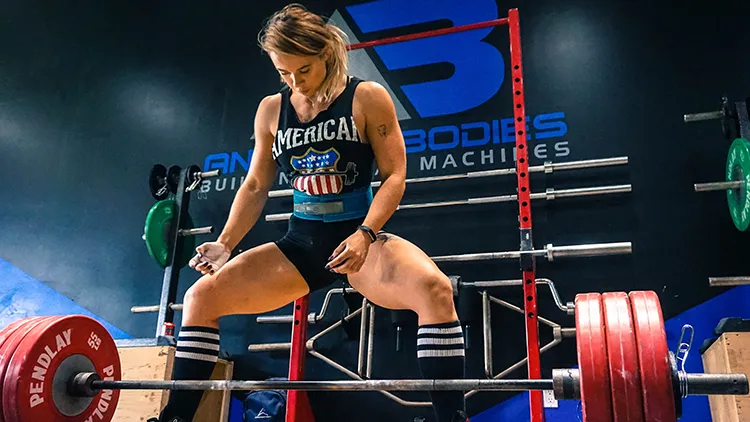
Source: Alora Griffiths from17
These lifts are both phenomenal exercises for building strength, speed, volatility, muscle size, and desired physique. Though they generally work the same muscles, there are some key differences in the hang clean vs power clean that can help any lifter or athlete target certain muscles and improve their overall performance.
Frequently Asked Questions
What’s the Difference Between Hang Clean vs Power Clean vs Jerk vs Clean Pull?
It can be difficult for those in beginner powerlifting programs–or anyone for that matter–to keep track of the differences in movements and benefits between the hang clean vs power clean vs jerk vs clean pull, so let’s briefly touch on each.
The hang clean starts with the bar at thigh level, the power clean starts with the weight on the floor, and the clean and jerk starts with the bar on the floor but ends with the body in full standing position with arms fully extended up. The hang clean pull is a smaller but vital motion in training for these other lifts.
When Should I Use a Hang Power Clean Over Hang Cleans and Power Cleans?
Beginners are advised to start with the hang clean as it is the safest and requires the smallest range of motion. Those in intermediate powerlifting programs or advanced powerlifting programs are more experienced and better prepared to move on to the extra pull and greater range of motion and muscle movement in the power clean, or can even advance to combining these two lifts into the aptly named hang power clean.
Clean vs Power Clean: What’s the Difference?
The main difference in the clean vs power clean is that in the clean the barbell is caught below a parallel squat position, while the power clean catch is above this position.
Are Hang Cleans vs Power Cleans Better?
There is no clear cut answer as to whether hang cleans vs power cleans are better because each lift targets and emphasizes muscles differently. Instead of thinking about which is “better”, instead one should consider their individual training goals and weigh the options and benefits of each lift to see which is most suitable for reaching those personal goals and benchmarks.
References
1Igor Alecsander. “Young female athlete practicing weightlifting.” Canva. Accessed 13 April 2023. <https://www.canva.com/photos/MAEEADMZnJ0-young-female-athlete-practicing-weightlifting/>
2Wikipedia the Free Encyclopedia. (2018, November 30). Hang clean (weightlifting). Wikipedia. Retrieved January 27, 2023, from <https://en.wikipedia.org/wiki/Hang_clean_(weightlifting)>
3Comfort, P., Allen, M., & Graham-Smith, P. (2011, December). Kinetic comparisons during variations of the power clean. National Institute of Health. Retrieved January 27, 2023, from <https://pubmed.ncbi.nlm.nih.gov/22080325/>
4Wikipedia the Free Encyclopedia. (2022, July 8). Hook grip. Wikipedia. Retrieved January 27, 2023, from <https://en.wikipedia.org/wiki/Hook_grip>
5Hirurg. “Weightlifting practice.” Canva, 20 April 2019. Accessed 13 April 2023. <https://www.canva.com/photos/MAFbr6qRuqY-weightlifting-practice/>
6vientocuatrostock. “Young Female Weightlifter Exercising in Gym.” Canva, 20 April 2019. Accessed 13 April 2023. <https://www.canva.com/photos/MAD07FSSbv4-young-female-weightlifter-exercising-in-gym/>
7vientocuatrostock. “Young Female Weightlifter Exercising in Gym.” Canva, 20 April 2019. Accessed 13 April 2023. <https://www.canva.com/photos/MAD07LNwr3M-young-female-weightlifter-exercising-in-gym/>
8South_agency. “Weightlifting exercise.” Canva, 13 December 2011. Accessed 13 April 2023. <https://www.canva.com/photos/MAEJOqlGWvU-weightlifting-exercise/>
9StefanDahl. “Fit Young Woman Weightlifting during a Gym Class.” Canva, 20 April 2019. Accessed 13 April 2023. <https://www.canva.com/photos/MADcv9uGe_0-fit-young-woman-weightlifting-during-a-gym-class/>
10urbazon. “Woman weightlifting.” Canva, 20 April 2019. Accessed 13 April 2023. <https://www.canva.com/photos/MAEI1VACOzs-woman-weightlifting/>
11svetikd. “Weightlifting class.” Canva. Accessed 13 April 2023. <https://www.canva.com/photos/MAEJMCKFNL4-weightlifting-class/>
12vientocuatrostock. “Young Female Weightlifter Exercising in Gym.” Canva, 13 December 2011. Accessed 13 April 2023. <https://www.canva.com/photos/MAD07GCilUs-young-female-weightlifter-exercising-in-gym/>
13Wikipedia the Free Encyclopedia. (2021, October 11). Posterior chain. Wikipedia. Retrieved January 27, 2023, from <https://en.wikipedia.org/wiki/Posterior_chain>
14Santos, P., Vaz, J., Correia, P., Valamatos, M., Veloso, A., & Pezarat-Correia, P. (2020, December). Muscle Synergies Reliability in the Power Clean Exercise. National Institute of Health. Retrieved January 27, 2023, from <https://www.ncbi.nlm.nih.gov/pmc/articles/PMC7739416/>
15Harvard University Natural Sciences. (2023). Erector Spinae Muscle Forces. Harvard University. Retrieved January 27, 2023, from <https://sciencedemonstrations.fas.harvard.edu/presentations/erector-spinae-muscle-forces>
16Marriner, C., Cronin, J., Macadam, P., & Storey, A. (2017, October). Redistributing load using wearable resistance during power clean training improves athletic performance. Redistributing load using wearable resistance during power clean training improves athletic performance. Retrieved January 27, 2023, from <https://pubmed.ncbi.nlm.nih.gov/28792857/>